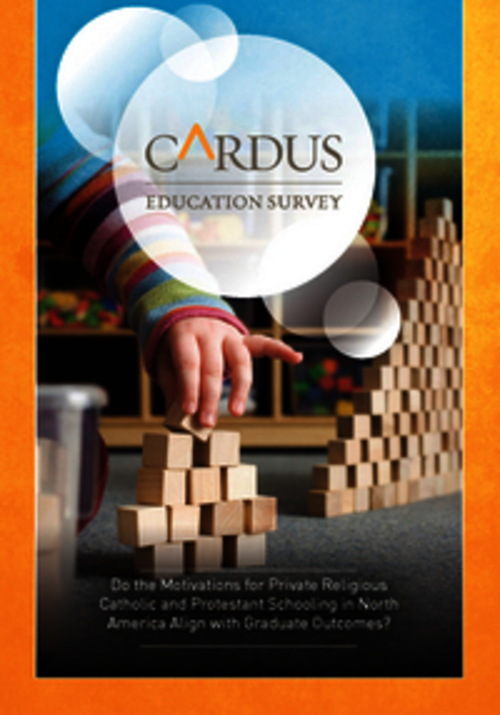To read the full article, click here .

The Cardus Survey results – part 2
October 22, 2011

Finding a place for God in the city
The newest downtown office building now rises above all others, the crescent-shaped building called The Bow. When completed next year, civic leaders intend it to be more than a symbol of Calgary's economic power. The hope is that it will lead a revitalization of the east side of downtown, where a new office tower hasn't gone up for 25 years. The Bow will be a Calgary landmark to be sure, but what kind of downtown will it preside over? What constitutes downtown development was the subject of an innovative report released here last week by Cardus, a think-tank that seeks to bring the Christian tradition to bear on our social architecture, as they put it. (Though I am a senior fellow at Cardus, I was not involved in this project, except to promote its launch.) The "Calgary City Soul" project asks a simple question: Are places of worship important in downtown development? Visions for downtown usually include office towers, high-end retail, residential buildings and space for parks and culture - libraries, museums, opera houses, theatres and art galleries. In recent years, for both commuting and environmental reasons, a desire has emerged to increase downtown density, so greater attention is now paid to how more people might live downtown. Where will the schools be? Will there be markets in walking distance? A few years back the City of Calgary updated its City Centre Plan, laying out what would be needed over the next decades if Calgary were to add as many as 70,000 people to the city core. It was the type of comprehensive planning document that is massively influential - and rather dull. But the folks at Cardus read such stuff and noticed that places of worship were totally ignored in the planning process - not even mentioned, except as a heritage conservation issue. Perhaps it was thought that none of the new downtown residents would be churchgoers. Or more likely, that whatever the churches had to offer would not contribute to downtown development. The Calgary City Soul project (Cardus.ca) argues that such an oversight was a critical failure. "Beliefs may be private or personal matters, but the institutions that nurture them have long been and remain public and part of, not apart from, the secular society represented by governments," the report argues. "Faith institutions have long played a critical role in the social fabric of vital cities. The effectiveness and efficiency of these institution's social services often surpasses what can be delivered by govern-ment agencies, owing in part to the very localized and socially embedded nature of the service delivery represented by faith institutions." Without the churches downtown, who will look after the suffering on the streets? The same day the Cardus report was released, Mayor Naheed Nenshi was at a morning faith breakfast, speaking about the critical role of religious institutions in the city's homelessness project. The data gathered by the report make it clear that faith-based institutions of social service are critical in Calgary, as they are in many other cities. Often it is the church shelters and programs which are the last resort in an emergency. So it makes good civic sense to plan creatively for churches, synagogues, temples and mosques downtown. Megaprojects like The Bow will bring a lot of new investment downtown, but precisely these new office, retail and residential projects - most of them highend - drive up the cost of being downtown. Churches are not great revenue generators, especially downtown where populations are transient and the physical plant is likely old and expensive to maintain. Without a vision that makes room for religious congregations downtown, the forces of "renewal" will slowly squeeze them out. Good social policy attempts to keep them in. Yet it is more than just good social policy. Religion downtown is not just about caring for the bodies of those who are on the streets. It is about the soul of the city. A city that has no room in its heart for the things of God is simply a less human city. Busy and productive it may be, but lacking an essential purpose and a deeper meaning for all the work. The grandest street in the world, Fifth Avenue in New York, features the noblest of human culture - the New York Public Library - and the rather crass Trump Tower - within a few blocks of each other. But were it not for St. Patrick's Cathedral between them, the whole street would be impoverished. The skyscrapers are not the only things that should point the human spirit toward the heights.
October 20, 2011

Jonathan Chaplin publishes, Multiculturalism: A Christian Retrieval
Recent years have seen an astonishingly rapid volte face regarding multiculturalism in Britain. Once political orthodoxy, it is now almost a by-word for segregation, exclusion and security threats. In this report, Jonathan Chaplin argues that in our haste to reassess multiculturalism in the light of evidence of its darker sides, we must not lose sight of its indispensable contribution to realising a just society. Tracing the history of multiculturalism and clarifying precisely what is at stake in the debate, Chaplin offers a vision of "multicultural justice", drawn from the resources of Christian social thought, but accessible and persuasive to those outside of the Christian faith. To read this report in full, click here.
October 20, 2011

Shooting Up on Power
The Harper government is spending $28 million to have middle-aged jumbotron-sized gentlemen dress up as soldiers and re-enact the War of 1812. Meanwhile, Canada’s Parliament, 2011, has just suffered an assault by the provinces and the Supreme Court that, unless beaten back, overturns the constitutional order of Confederation. On September 30, Canada’s highest court handed down its decision in the Insite case. The judgment ostensibly involved a so-called safe injection site in Vancouver where addicts can shoot up street drugs such as heroin. The federal government had ordered a review of the experimental facility and was leaning toward closing it down. Read the rest of the article here.
October 19, 2011

Private Non-Religious Schools
To read the full article, click here .
October 17, 2011

Construction associations call for infrastructure focus from Ontario Liberals
Daily Commercial news on the Cardus report calling for an end to the Ontario College of Trades. Quote: "Renkema hopes the Liberals will give some attention to the reports that have been conducted on the College of Trades, like the Cardus report entitled “College of Trades: An impossible institutionâ€, which has many construction employers calling for the abolition or complete overhaul of the institution." Read the whole article here.
October 17, 2011

Institutions of faith help define Calgary
Since the dawn of civilization, the physical and social architecture of great cities and societies have been defined by their institutions of faith. From the ancient pyramids of Giza and Teotihuacan, Malta’s Hagar Qim, Greece’s Temple of Afea, King Solomon’s Temple in Jerusalem, Medina’s Quba Mosque, Petra, Harmandir Sahib in Amritsar, Delhi’s Chhatarpur Temple, Wat Arun in Bangkok, Notre Dame in Paris, St. Paul’s in London, St. Peter’s in Rome, St. Basil’s in Moscow, St. Patrick’s in New York, Marie Reine du Monde in Montreal through to the Salt Lake Temple, institutions of faith have been at the physical, social and metaphorical hearts of our cities. The goal of sacred architecture, according to architect Norman Koonce, is to make “transparent the boundary between matter and mind, flesh and the spirit.” The question posed by the results of the Calgary City Soul Phase 2 study being released today by Cardus — a think-tank dedicated to the study of social architecture — is whether that tradition will be relegated to the city’s suburbs or whether it will have the opportunity to evolve within the city’s heart. Further, unless the city amends the Centre City Plan, it appears unlikely that the increasingly large numbers of new Calgarians who subscribe to faiths other than Christianity will have the opportunity to establish their communities within the civic core. Undertaken through a contract with the Arlington Group — an established urban consultancy — the Calgary City Soul project was conceived following a one-day Cardus seminar in September 2008. At that time, it was noticed that the City of Calgary’s Centre City Plan — a comprehensive and visionary planning document designed to attract an additional 40,000 to 70,000 residents into the civic core — had overlooked any current or future role for institutions of faith. It was then, and remains our belief, that this was not done through intention, but through oversight, perhaps due to the extent to which faith has been — incorrectly — privatized. Beliefs may, indeed, be private or personal matters, but the institutions that nurture them have long been and remain public and part of, not apart from, a secular society. The benefits of faith cannot be contained by the physical walls of worship spaces. In fact, there is plenty of evidence that faith communities serve an important role as a catalyst for volunteering, charity and caring for neighbours. The marginalization of faith institutions is not about how we treat those who frequent them, which includes incidentally a growing minority of religiously observant minorities who are not being served by any worship spaces of their tradition within the city core. It also bruises the very soul of the city and lessens our capacity in matters as diverse as implementing an emergency plan (for which worship facilities and volunteer networks have historically proved critical) to the range of arts and cultural events that Calgarians enjoy. In an address to the Yale University School of Architecture, Toronto’s former poet laureate, Pier Giorgio di Cicco, put it this way: “The principles of sacred space are: the elicitation of wonder; the imperative of stillness; the benevolent connotation of forces that nurture, gentle and release.” “The onus in the 21st century will not be diversity of culture,” but “diversity of spirituality. . . . It will behoove the architect, the planner to design public space that mediates the spiritual instinct to communality and transcendence. The communing of streetscape, landscape, building, skyline enjoins the citizen to commune with projects and entities and re-establishes trust with others. . . . The effect of architecture and space on the entire person, in the advent and presence of other persons is universal. It gentles the civic creature. It can gentle disparate cultures and peoples by the vocabulary of the sublime, bringing them to the point of awe, gratitude and mutuality by shared space, making such space sacred.” These are the structures that nurture people’s most deeply held beliefs, sanctify their lives’ most vital relationships and comfort their deepest pains and most profound sorrows. And, even for those who do not share their faith, they act, as the Arlington Group’s report for Cardus articulates, as incubators of commonly held social virtues. Similar to the esthetic influence of the arts on a community, their impact on the culture that surrounds them is felt and is of benefit to even those who never, or rarely, enter them. The full report, available on the Cardus website, confirms that, as C.S. Lewis said, “the church is the only organization that exists for the benefit of non-members.” We at Cardus are, therefore, recommending that city council amend the Centre City Plan to reflect our civic leaders’ understanding that institutions of faith exists as part of – not apart from – a truly secular society.
October 11, 2011

Having faith in our city core
The City of Calgary will exclude new ethnic and faith communities from growing and prospering within the civic core unless the Centre City Plan is amended, according to a study released today by Cardus, a think tank dedicated to the study of social architecture. The Calgary City Soul project, Phase Two of which is released today, was conceived in September 2008 when we at Cardus noticed the Centre City Plan — a comprehensive, visionary planning document designed to attract up to 70,000 more residents into the civic core — had overlooked the city-building role that institutions of faith play. It remains our belief this was not done through intention, but through simple oversight. Beliefs may be private or personal matters, but the institutions that nurture them have long been and remain public and part of, not apart from, the secular society government represents Phase One of our study indicated that within the boundaries of the Centre City Plan (which redefined “downtown” Calgary), there are 25 spaces devoted to worship, mostly Christian churches and one Buddhist Temple. There are no synagogues, mosques, Latter Day Saints, Sikh or Hindu temples now within the civic core. Nor, as stated, did the Centre City Plan specify room for any of these or for new Christian institutions to serve those whom the plan hoped to entice into a revitalized core. Phase Two examined whether or not the current plan created the unintended consequence of social exclusion. Its conclusions indicate institutions of faith play a strong and vital role within the city’s social architecture not only for persons of faith but for all citizens. Further, the demographic makeup of the civic core is significantly different from the city’s overall demographics and bears more resemblance to the “old” Calgary than the “new” Calgary. The changing nature of our society is vividly outlined in census data showing that prior to 1961, 83% of immigrants to Calgary were of a defined Christian background. Of these, 44% were Protestant and 33% Catholic; 1% were Jewish; 1% Buddhist; and the Muslim, Sikh and Hindu immigration numbers were so negligible they were recorded as 0%. The latest census data available in terms of faith affiliation (2001) outlines a dramatic shift that has fundamentally altered the nature of our city and its cultural influencers. Muslims now represent the second largest immigrant faith group (14%), trailing only Catholics at 26%. Protestant numbers have plummeted to 12%, ahead of Sikhs at 7%, Buddhists at 5% and Hindus at 3%. Jewish immigration remains at 1%. The percentage of Christians immigrating to Calgary has dropped in 40 years from 83% to 49%. Should this trend continue for the next 20 years, only 32% of new immigrants to Calgary will be Christian while as many as one in four may be Muslim and one in 10 Sikh. It is not unreasonable to anticipate new numbers will show a continuation of these trends. While the nature of Calgary’s faith affiliation has changed significantly, faith continues to be an identifying cultural characteristic in the lives of 8 in 10 Calgarians. The one-in-four of the city’s citizens who attend an institution of faith on a weekly basis — a considerable commitment — represent roughly nine unique sold-out crowds at McMahon Stadium or two unique sell-outs a day, seven days a week at the Saddledome. We recommend, therefore, that the city amend the Centre City Plan to recognize the vital role that institutions of faith play in the social architecture of a great city.
October 11, 2011

Dijkema responds, defends impossibility of College of Trades
Senior Researcher Brian Dijkema responds to union criticisms of the Cardus study on the Ontario College of Trades. He writes: It appears union leaders defending the College of Trades think (“Proponents Stand Up for College of Trades,†Oct. 3 ) the recent Cardus research (“College of Trades: An Impossible Institutionâ€) is “political†and lacking objectivity. The IBEW’s John Grimshaw goes so far as suggesting that since Cardus “didn’t ask us, they certainly didn’t ask our employers, so I don’t know where they figure they got their research.†Their defence actually makes our point. Our April 2011 study of the College (“Where is the Research?â€) highlighted that no publicly available data has been produced to support basic premises of the legislation. It would seem that Mr. Dillon et al have either not read the report, or that they are deliberately ignoring its methodology and content. Read the rest of his Letter to the Editor here.
October 11, 2011
Media Contact
Daniel Proussalidis
Director of Communications
